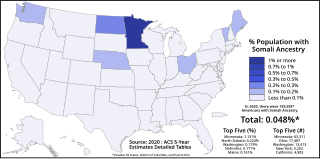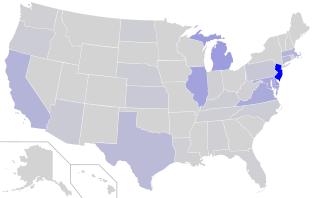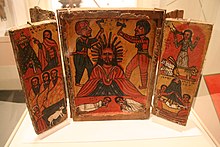
Arab Americans are Americans of Arab ancestry. Arab Americans trace ancestry to any of the various waves of immigrants of the countries comprising the Arab World.
Egyptian Americans are Americans of partial or full Egyptian ancestry. The 2016 US Census estimated the number of people with Egyptian ancestry at 256,000, most of whom are from Egypt's Christian Orthodox Coptic minority. Egyptian Americans may also include the Egyptian foreign-born population in the United States. The US Census Bureau estimated in 2016 that there were 181,677 foreign-born Egyptians in the United States. They represented around 0.4% of the total US foreign-born population as 42,194,354 first-generation immigrants in 2016. Egyptians are concentrated in New York City and Los Angeles. California has the largest Egyptian population by state.

Bangladeshi Americans are Americans of Bangladeshi descent. Most Bangladeshi Americans are also Bengali Americans. Bangladeshi Americans are usually Muslims with roots in Bangladesh in which Bengali is the majority language. Since the early 1970s, Bangladeshi immigrants have arrived in significant numbers to become one of the fastest growing ethnic groups in the U.S. New York City is home to two-thirds of the Bangladeshi American population. Meanwhile, Paterson, New Jersey and Atlantic City, New Jersey are also home to notable Bangladeshi communities. Over 400,000 people leave Bangladesh with the sole goal of finding employment in other countries.
Tibetan Americans are Americans of Tibetan ancestry. As of 2020, more than 26,700 Americans are estimated to have Tibetan ancestry. The majority of Tibetan Americans reside in Queens, New York.

Russian Americans are Americans of full or partial Russian ancestry. The term can apply to recent Russian immigrants to the United States, as well as to those who settled in the 19th century Russian possessions in northwestern America. Russian Americans comprise the largest Eastern European and East Slavic population in the U.S., the second-largest Slavic population generally, the nineteenth-largest ancestry group overall, and the eleventh-largest from Europe.

Minnesota's 4th congressional district covers nearly all of Ramsey County, and part of Washington County. It includes all of St. Paul, and most of its northern and eastern suburbs, including Woodbury, Blaine, Roseville, and Maplewood. The district is solidly Democratic, with a CPVI of D+17. It is currently represented by Betty McCollum, of the Minnesota Democratic-Farmer-Labor Party (DFL). The DFL has held the seat without interruption since 1949, and all but one term (1947–1949) since the merger of the Democratic and Farmer-Labor Parties.
African immigration to the United States refers to immigrants to the United States who are or were nationals of modern African countries. The term African in the scope of this article refers to geographical or national origins rather than racial affiliation. From the Immigration and Nationality Act of 1965 to 2017, Sub-Saharan African-born population in the United States grew to 2.1 million people.

The Somali diaspora or Qurbajoogta refers to Somalis who were born in Greater Somalia and reside in areas of the world that they were not born in. The civil war in Somalia greatly increased the size of the Somali diaspora, as many Somalis moved from Greater Somalia primarily to Europe, North America, Southern Africa and Australia. There are also small Somali populations in other pockets of Europe and Asia. The UN estimates that in 2015, approximately 2 million people from Somalia were living outside of the country's borders.

Somali Americans are Americans of Somali ancestry. The first ethnic Somalis to arrive in the U.S. were sailors who came in the 1920s from British Somaliland. They were followed by students pursuing higher studies in the 1960s and 1970s, by the late 1970s through the late 1980s and early 1990s more Somalis arrived. However, it was not until the mid and late 1990s when the civil war in Somalia broke out that the majority of Somalis arrived in the United States. The Somali community in the U.S. is now among the largest in the Somali diaspora.
Kenyan Americans are an ethnic group of Americans of Kenyan descent and ancestry. As of the 2010 census, there were an estimated 92,638 Kenyan-born persons living in the United States. Most Kenyan Americans are concentrated in Minneapolis-St. Paul, Seattle, Texas, Maryland, Georgia, New York, North Carolina, and the greater Washington, D.C. area.
Israeli Jews or Jewish Israelis comprise Israel's largest ethnic and religious community. The core of their demographic consists of those with a Jewish identity and their descendants, including ethnic Jews and religious Jews alike. Approximately 99% of the global Israeli Jewish population resides in Israel; yerida is uncommon and is offset exponentially by aliyah, but those who do emigrate from the country typically relocate to the Western world. As such, the Israeli diaspora is closely tied to the broader Jewish diaspora.
The District of Columbia is a federal district with an ethnically diverse population. In 2020, the District had a population of 689,545 people, with a resident density of 11,515 people per square mile.
Israeli Americans are Americans who are of full or partial Israeli descent. In this category are those who are Israelis through nationality and/or citizenship. Reflecting Israel's demographics, while the vast majority of the Israeli American populace is Jewish, it is also made up of various ethnic and religious minorities; most notably the ethnic Arab minority, which includes Christians, Druzes, and Muslims, as well as the smaller non-Arab minority ethnic groups.

The demographics of Filipino Americans describe a heterogeneous group of people in the United States who trace their ancestry to the Philippines. As of the 2020 Census, there were 4.4 million Filipino Americans, including Multiracial Americans who were part Filipino living in the US. Filipino Americans constitute the third-largest population of Asian Americans, and the largest population of Overseas Filipinos.

There have been a variety of ethnic groups in Baltimore, Maryland and its surrounding area for 12,000 years. Prior to European colonization, various Native American nations have lived in the Baltimore area for nearly 3 millennia, with the earliest known Native inhabitants dating to the 10th millennium BCE. Following Baltimore's foundation as a subdivision of the Province of Maryland by British colonial authorities in 1661, the city became home to numerous European settlers and immigrants and their African slaves. Since the first English settlers arrived, substantial immigration from all over Europe, the presence of a deeply rooted community of free black people that was the largest in the pre-Civil War United States, out-migration of African-Americans from the Deep South, out-migration of White Southerners from Appalachia, out-migration of Native Americans from the Southeast such as the Lumbee and the Cherokee, and new waves of more recent immigrants from Latin America, the Caribbean, Asia and Africa have added layers of complexity to the workforce and culture of Baltimore, as well as the religious and ethnic fabric of the city. Baltimore's culture has been described as "the blending of Southern culture and [African-American] migration, Northern industry, and the influx of European immigrants—first mixing at the port and its neighborhoods...Baltimore’s character, it’s uniqueness, the dialect, all of it, is a kind of amalgamation of these very different things coming together—with a little Appalachia thrown in...It’s all threaded through these neighborhoods", according to the American studies academic Mary Rizzo.

Palestinian Americans are Americans who are of full or partial Palestinian descent. It is unclear when the first Palestinian immigrants arrived in the United States, but it is believed that they arrived during the early 1900s.
There is a large Ethiopian American community in the Washington, D.C. metropolitan area. According to the Embassy of Ethiopia, this was the largest ethnic Ethiopian community outside of Africa.
Central Asians in the United States are Americans with ancestry from Central Asia. They include Kazakh, Kyrgyz, Tajik, Turkmen, and Uzbek individuals. People of Afghan, Baloch, and Uyghur descent are also sometimes classified as Central Asians. The United States census does not mention Central Asians under any category.

Telugu Americans are citizens of the United States of America who belong to the Telugu ethnic group. The vast majority of Telugu Americans trace their ancestry to the Indian states of Andhra Pradesh and Telangana, but also from other neighbouring states including Karnataka, Tamil Nadu, Odisha, Maharashtra, etc. Most of the Telugus that have migrated during 20th century were from the Krishna and Godavari delta regions of the Madras Presidency. During the 21st century, after the dot-com boom, Telugus from all regions of Andhra Pradesh and Telangana started migrating in high numbers.

















